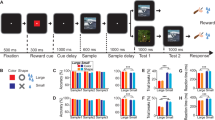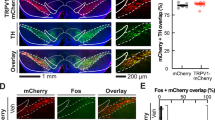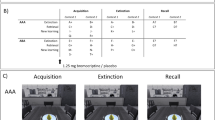Abstract
Working memory is regulated by neurotransmitters in prefrontal cortex (PFC), including dopamine and norepinephrine. Previous studies of dopamine function in working memory have focused on the D1 and D2 receptors, with most evidence suggesting a dominant role for the D1 receptor. Since the dopamine D4 receptor is highly expressed in PFC, we hypothesize that it may also contribute to working memory. To test this hypothesis, we examined behavioral effects of L-745,870, a highly selective, centrally active, D4 antagonist, using a delayed alternation task in rats. Task performance was dose-dependently affected by the D4 antagonist, depending on individual baseline functional status of working memory. In rats with good baseline performance, the D4 antagonist had no effects at low doses, whereas high doses disrupted working memory. In rats with poor baseline working memory, the D4 antagonist significantly improved working memory at low doses, and higher doses were not distinguishable from vehicle controls. Effects of the D4 antagonist among poor performers were most robust when task demand for working memory was high, with lesser effects at lower demand level, suggesting that such effects were selective for working memory. The present findings indicate a significant role of the D4 receptor in working memory, and suggest innovative, D4-based, treatment of cognitive deficits associated with neuropsychiatric disorders.
Similar content being viewed by others
Log in or create a free account to read this content
Gain free access to this article, as well as selected content from this journal and more on nature.com
or
References
Aggleton JP, Hunt PR, Rawlins JNP (1986). The effects of hippocampal lesions upon spatial and non-spatial tests of working memory. Behav Brain Res 19: 133–146.
Ariano MA, Wang J, Noblett KL, Larson ER, Sibley DR (1997). Cellular distribution of the rat D4 dopamine receptor protein in the CNS using anti-receptor antisera. Brain Res 752: 26–34.
Arnsten AFT, Cai JX, Murphy BL, Goldman-Rakic PS (1994). Dopamine D1 receptor mechanisms in the cognitive performance of young adult and aged monkeys. Psychopharmacology 116: 143–151.
Arnsten AFT, Goldman-Rakic PS (1998). Noise stress impairs prefrontal cortical cognitive function in monkeys: evidence for a hyperdopaminergic mechanism. Arch Gen Psychiatry 55: 362–368.
Arnsten AFT, Murphy B, Merchant K (2000). The selective dopamine D4 receptor antagonist, PNU-101387G, prevents stress-induced cognitive deficits in monkeys. Neuropsychopharmacology 4: 405–410.
Aultman JM, Moghaddam B (2001). Distinct contributions of glutamate and dopamine receptors to temporal aspects of rodent working memory using a clinically relevant task. Psychopharmacology 15: 353–364.
Baddeley AD (1986). Working Memory. Claredon: Oxford.
Battig K, Rosvold HE, Mishkin M (1960). Comparison of the effects of frontal and caudate lesions on delayed response and alternation in monkeys. J Comp Physiol Psychol 53: 400–404.
Brito GNO, Thomas GJ (1981). T-maze alternation, response patterning, and septo-hippocampal circuitry in rats. Behav Brain Res 3: 319–340.
Broderick PA, Piercey MF (1998). Clozapine, haloperidol, and the D4 antagonist PNU-101387G: in vivo effects on mesocortical, mesolimbic, and nigrostriatal dopamine and serotonin release. J Neural Transm 105: 749–767.
Brozoski TJ, Brown RM, Rosvold HE, Goldman PS (1979). Cognitive deficit caused by regional depletion of dopamine in prefrontal cortex of rhesus monkey. Science 205: 929–932.
Bubser M, Schmidt WJ (1990). 6-Hydroxydopamine lesion of the rat prefrontal cortex increases locomotor activity, impairs acquisition of delayed alternation tasks, but does not affect uninterrupted tasks in the radial maze. Behav Brain Res 37: 157–168.
Bushnell PJ, Levin ED (1993). Effects of dopaminergic drugs on working and reference memory in rats. Pharmacol Biochem Behav 45: 765–776.
Cai JX, Arnsten AFT (1997). Dose-dependent effects of the dopamine D1 receptor agonists A77636 or SKF81297 on spatial working memory in aged monkeys. J Pharmacol Exp Ther 283: 183–189.
Castner SA, Williams GV, Goldman-Rakic PS (2000). Reversal of antipsychotic-induced working memory deficits by short-term dopamine D1 receptor stimulation. Science 287: 2020–2022.
Constantinidis C, Williams GV, Goldman-Rakic PS (2002). A role for inhibition in shaping the temporal flow of information in prefrontal cortex. Nat Neurosci 5: 175–180.
Corrigan MH, Gallen CC, Bonura ML, Merchant KM (2004). Effectiveness of the selective D4 antagonist sonepipirazole in schizophrenia: a placebo-controlled trial. Biol Psychiatry 55: 445–451.
Davids E, Zhang K, Baldessarini RJ (2002). Stereoselective effects of methylphenidate on hyperactivity in juvenile rats induced by neonatal 6-hydroxydopamine lesioning. Psychopharmacology 160: 92–98.
Dember WN, Fowler H (1958). Spontaneous alternation behavior. Psychol Bull 55: 412–428.
Denney CB, Rapport MD (2001). Cognitive pharmacology of stimulants in children with ADHD. In: Solanto MV, Arnsten AFT, Castellanos FX (eds). Stimulant Drugs and ADHD. Oxford University Press: New York. pp 283–302.
Didriksen M (1995). Effects of antipsychotics on cognitive behaviour in rats using the delayed non-match to position paradigm. Eur J Pharmacol 281: 241–250.
Faraone SV, Doyle AE, Mick E, Biederman J (2001). Meta-analysis of the association between the 7-repeat allele of the dopamine D4 receptor gene and attention deficit hyperactivity disorder. Am J Psychiatry 158: 1052–1057.
Freedman M, Oscar-Berman M (1986). Bilateral frontal lobe disease and selective delayed response deficits in humans. Behav Neurosci 100: 337–342.
Goldman PS, Rosvold HE, Vest B, Galkin TW (1971). Analysis of the delayed-alternation deficit produced by dorsolateral prefrontal lesions in the rhesus monkey. J Comp Physiol Psychol 77: 212–220.
Goldman-Rakic PS (2001). Working memory dysfunction in schizophrenia. In: Salloway SP, Malloy PF, Duffy JD (eds). The Frontal Lobes and Neuropsychiatric Illness. American Psychiatric Publishing: Washington, DC. pp 71–82.
Jentsch JD, Taylor JR, Redmond Jr ED, Elsworth JD, Youngren KD, Roth RH (1999). Dopamine D4 receptor antagonist reversal of subchronic phencyclidine-induced object retrieval/detour deficits in monkeys. Psychopharmacology 142: 78–84.
Kolb B, Nonneman AJ, Singh RK (1974). Double dissociation of spatial impairments and perseveration following selective prefrontal lesions in rats. J Comp Physiol Psychol 87: 772–780.
Kramer MS, Last B, Geston A, Reines SA (1997). The effects of a selective D4 dopamine receptor antagonist (L-745,870) in acutely psychotic inpatients with schizophrenia. Arch Gen Psychiatry 54: 567–572.
La Hoste GJ, Swanson JM, Wigal SB, Glabe C, Wigal T, King N, Kennedy JL (1996). Dopamine D4 receptor gene polymorphism is associated with attention deficit hyperactivity disorder. Mol Psychiatry 1: 128–131.
Lanau F, Zenner MT, Civelli O, Hartman DS (1997). Epinephrine and norepinephrine act as potent agonists at the recombinant human dopamine D4 receptor. J Neurochem 68: 804–812.
Larsen JK, Divac I (1978). Selective ablations within the prefrontal cortex of the rat and performance of delayed alternation. Physiol Psychol 6: 15–17.
Mansbach RS, Brooks EW, Sanner MA, Zorn SH (1998). Selective dopamine D4 receptor antagonists reverse apomorphine-induced blockade of prepulse inhibition. Psychopharmacology 135: 194–200.
Mattay VS, Callicott JH, Bertolino A, Heaton I, Frank JA, Coppola R et al (2000). Effects of dextroamphetamine on cognitive performance and cortical activation. Neuroimage 12: 268–275.
Mattay VS, Goldberg TE, Fera F, Hariri AR, Tessitore A, Egan MF et al (2003). Catechol O-methyltransferase val158-met genotype and individual variation in the brain response to amphetamine. Proc Natl Acad Sci USA 100: 6186–6191.
Millan MJ, Newman-Tancredi A, Brocco M, Gobert A, Lejeune F, Audinot A et al (1998). S 18126 (2-[4-(2,3-dihydrobenzo[1,4]dioxin-6-yl)piperazin-1-yl methyl]indan-2-yl), a potent, selective and competitive antagonist at dopamine D4 receptors: an in vitro and in vivo comparison with L 745,870 (3-(4-[4-chlorophenyl]piperazin-1-yl)methyl-1H-pyrrolo[2,3b]pyridine) and raclopride. J Pharmacol Exp Ther 287: 167–186.
Mizoguchi K, Yuzurihara M, Ishige A, Sasaki H, Chui D, Tabira T (2000). Chronic stress induces impairment of spatial working memory because of prefrontal dopaminergic dysfunction. J Neurosci 20: 1568–1574.
Mrzljak L, Bergson C, Pappy M, Huff R, Levenson R, Goldman-Rakic PS (1996). Localization of dopamine D4 receptors in GABAergic neurons of the primate brain. Nature 381: 245–248.
Murphy BL, Arnsten ATF, Goldman-Rakic PS, Roth RH (1996). Increased dopamine turnover in the prefrontal cortex impairs spatial working memory performance in rats and monkeys. Pro Natl Acad Sci USA 93: 1325–1329.
Oaks JN, Oldenhof J, Van Tol HHM (2000). The dopamine D4 receptor: one decade of research. Eur J Pharmacol 405: 303–327.
Patel S, Freedman S, Chapman KL, Emms F, Flectcher AE, Knowles M et al (1997). Biological profile of L-745,870, a selective antagonist with high affinity for the dopamine D4 receptor. J Pharmacol Exp Ther 283: 636–647.
Pennington BF, Ozonoff S (1996). Executive functions and developmental psychopathology. J Child Psychol Psychiat 37: 51–87.
Pisa M (1981). Amnesia for discrete events in rats with fornicotomies: effects of interference on spatial alternation performance. J Comp Physiol Psychol 95: 924–942.
Rao SG, Williams GV, Goldman-Rakic PS (1999). Isodirectional tuning of adjacent interneurons and pyramidal cells during working memory: evidence for microcolumnar organization in PFC. J Neurophysiol 81: 1903–1916.
Rubinstein M, Cepeda C, Hurst RS, Flores-Hernandez J, Ariano MA, Falzone T et al (2001). Dopamine D4 receptor-deficient mice display cortical hyperexcitability. J Neurosci 21: 3756–3763.
Rubinstein M, Phillips TJ, Bunzow JR, Falzone TL, Dziewczapolski G, Zhang G et al (1997). Mice lacking dopamine D4 receptors are supersensitive to ethanol, cocaine, and methamphetamine. Cell 90: 991–1001.
Sawaguchi T, Goldman-Rakic PS (1991). D1 dopamine receptors in prefrontal cortex: involvement in working memory. Science 251: 947–950.
Sawaguchi T, Goldman-Rakic PS (1994). The role of D1-dopamine receptor in working memory: local injections of dopamine antagonists into the prefrontal cortex of rhesus monkeys performing an oculomotor delayed-response task. J Neurophysiol 71: 515–528.
Simon H (1981). Dopaminergic A10 neurons and frontal system. J Physiol 77: 81–95.
Stam CJ, de Bruin JP, van Haelst AM, van der Gugten J, Kalsbeek A (1989). Influence of the mesocortical dopaminergic system on activity, food hoarding, social-agonistic behavior, and spatial delayed alternation in male rats. Behav Neurosci 103: 24–35.
Svingos AL, Periasamy S, Pickel VM (2000). Presynaptic dopamine D4 receptor localization in the rat nucleus accumbens. Synapse 36: 222–232.
Tarazi FI, Baldessarini RJ (1999). Dopamine D4 receptors: significance for molecular psychiatry at the millennium. Mol Psychiatry 4: 529–538.
Van Tol HHM, Bunzow JR, Guan H-C, Sunahara RK, Seeman P, Niznik HB et al (1991). Cloning of a human dopamine D4 receptor gene with high affinity for the antipsychotic clozapine. Nature 350: 614–619.
Verin M, Partoit A, Pillon B, Malapani C, Agid Y, Dubois B (1993). Delayed response tasks and prefrontal lesions in man—evidence for self-generated patterns of behavior with poor environmental modulation. Neuropsychologia 31: 1279–1296.
Verma A, Moghaddam B (1996). NMDA receptor antagonists impair prefrontal cortex function as assessed via spatial delayed alternation performance in rats: modulation by dopamine. J Neurosci 16: 373–379.
Wang X, Zhong P, Yan Z (2002). Dopamine D4 receptor modulate GABAergic signaling in pyramidal neurons of prefrontal cortex. J Neurosci 22: 9185–9193.
Wedzony K, Chocyk A, Mackowiak M, Fijal K, Czyrak A (2000). Cortical localization of dopamine D4 receptors in the rat brain-immunocytochemical study. J Physiol Pharmacol 51: 205–221.
Williams GV, Goldman-Rakic PS (1995). Modulation of memory fields by dopamine D1 receptors in prefrontal cortex. Nature 37: 572–575.
Zahrt J, Taylor JR, Mathew RG, Arnsten AF (1997). Supranormal stimulation of D1 dopamine receptors in the rodent prefrontal cortex impairs spatial working memory performance. J Neurosci 17: 8528–8535.
Zhang K, Davids E, Tarazi FI, Baldessarini RJ (2002). Effects of dopamine D4 receptor-selective antagonists on motor hyperactivity in rats with neonatal 6-hydroxydopamine lesions. Psychopharmacology 161: 100–106.
Zhang K, Tarazi FI, Baldessarini RJ (2001). Role of dopamine D4 receptors in motor hyperactivity induced by neonatal 6-hydroxydopamine lesions in rats. Neuropsychopharmacology 25: 624–632.
Acknowledgements
This work was supported, in part, by a grant from the Bruce J Anderson Foundation and by the McLean Private Donors Neuropsychopharmacology Research Fund (to RJB). L-745,870 was generously donated by Merck (Rahway, NJ).
Author information
Authors and Affiliations
Corresponding author
Rights and permissions
About this article
Cite this article
Zhang, K., Grady, C., Tsapakis, E. et al. Regulation of Working Memory by Dopamine D4 Receptor in Rats. Neuropsychopharmacol 29, 1648–1655 (2004). https://doi.org/10.1038/sj.npp.1300491
Received:
Revised:
Accepted:
Published:
Issue date:
DOI: https://doi.org/10.1038/sj.npp.1300491
Keywords
This article is cited by
-
Therapeutic efficacy of repetitive transcranial magnetic stimulation in an animal model of Alzheimer’s disease
Scientific Reports (2021)
-
Bidirectional modulation of hippocampal synaptic plasticity by Dopaminergic D4-receptors in the CA1 area of hippocampus
Scientific Reports (2017)
-
Baseline-dependent effects of amphetamine on attention are associated with striatal dopamine metabolism
Scientific Reports (2017)
-
Improvement of attention with amphetamine in low- and high-performing rats
Psychopharmacology (2016)
-
Noradrenergic versus dopaminergic modulation of impulsivity, attention and monitoring behaviour in rats performing the stop-signal task
Psychopharmacology (2013)



